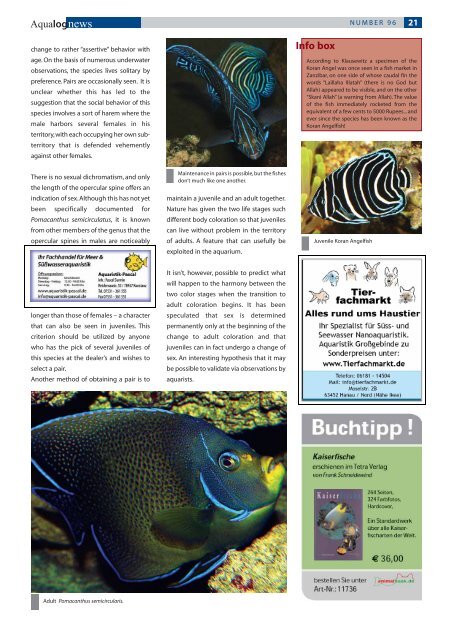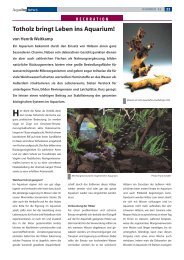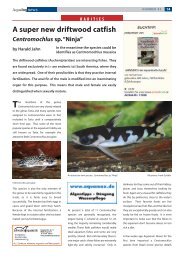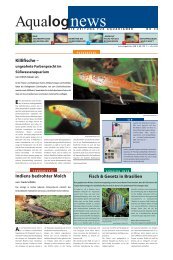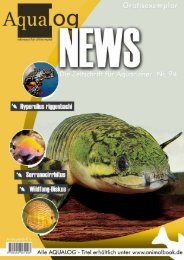Moenkhausia cosmops - Aqualog
Moenkhausia cosmops - Aqualog
Moenkhausia cosmops - Aqualog
You also want an ePaper? Increase the reach of your titles
YUMPU automatically turns print PDFs into web optimized ePapers that Google loves.
<strong>Aqualog</strong>news NUMBER 96 21<br />
change to rather “assertive” behavior with<br />
age. On the basis of numerous underwater<br />
observations, the species lives solitary by<br />
preference. Pairs are occasionally seen. It is<br />
unclear whether this has led to the<br />
suggestion that the social behavior of this<br />
species involves a sort of harem where the<br />
male harbors several females in his<br />
territory,with each occupying her own subterritory<br />
that is defended vehemently<br />
against other females.<br />
There is no sexual dichromatism, and only<br />
the length of the opercular spine offers an<br />
indication of sex. Although this has not yet<br />
been specifically documented for<br />
Pomacanthus semicirculatus, it is known<br />
from other members of the genus that the<br />
opercular spines in males are noticeably<br />
longer than those of females – a character<br />
that can also be seen in juveniles. This<br />
criterion should be utilized by anyone<br />
who has the pick of several juveniles of<br />
this species at the dealer’s and wishes to<br />
select a pair.<br />
Another method of obtaining a pair is to<br />
Adult Pomacanthus semicircularis.<br />
Maintenance in pairs is possible, but the fishes<br />
don’t much like one another.<br />
maintain a juvenile and an adult together.<br />
Nature has given the two life stages such<br />
different body coloration so that juveniles<br />
can live without problem in the territory<br />
of adults. A feature that can usefully be<br />
exploited in the aquarium.<br />
It isn’t, however, possible to predict what<br />
will happen to the harmony between the<br />
two color stages when the transition to<br />
adult coloration begins. It has been<br />
speculated that sex is determined<br />
permanently only at the beginning of the<br />
change to adult coloration and that<br />
juveniles can in fact undergo a change of<br />
sex. An interesting hypothesis that it may<br />
be possible to validate via observations by<br />
aquarists.<br />
Info box<br />
According to Klausewitz a specimen of the<br />
Koran Angel was once seen in a fish market in<br />
Zanzibar, on one side of whose caudal fin the<br />
words “Laillaha Illatah” (there is no God but<br />
Allah) appeared to be visible, and on the other<br />
“Skani Allah” (a warning from Allah). The value<br />
of the fish immediately rocketed from the<br />
equivalent of a few cents to 5000 Rupees... and<br />
ever since the species has been known as the<br />
Koran Angelfish!<br />
Juvenile Koran Angelfish


